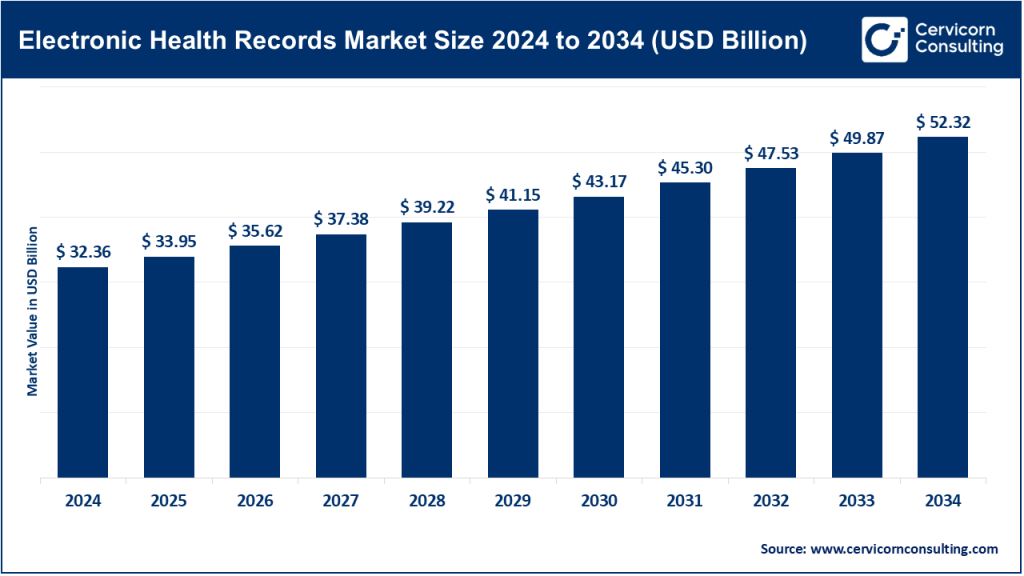Electronic Health Records Market Overview
The global electronic health records market size was worth USD 32.36 billion in 2024 and is anticipated to expand to around USD 52.32 billion by 2034, registering a compound annual growth rate (CAGR) of 6.6% from 2025 to 2034.
The electronic health records (EHR) market has emerged as a cornerstone in the transformation of healthcare systems globally. With increasing digitalization, mounting healthcare costs, and the need for efficient patient data management, the EHR market is experiencing strong momentum. Growth factors driving this market include government incentives for EHR adoption, the need for integrated healthcare systems, rising incidences of chronic diseases, increased demand for telemedicine integration, and rapid technological advancements such as AI, blockchain, and interoperability frameworks. The push for population health management, value-based care, and predictive analytics is further accelerating demand for robust EHR solutions worldwide.
What is the Electronic Health Records Market?
The Electronic Health Records market revolves around digital systems that store, manage, and share patients’ medical histories in a structured and secure format. EHR systems provide a real-time, patient-centered record that makes information instantly and securely available to authorized users. These records typically include a range of data—from demographics and medical history to medication, allergies, immunization status, radiology images, and laboratory test results. Unlike paper records, EHRs streamline clinical workflows, enhance coordination among healthcare providers, reduce medical errors, and improve overall quality of care.
Get a Free Sample: https://www.cervicornconsulting.com/sample/2680
Why Is It Important?
EHR systems play a critical role in modern healthcare delivery. By consolidating patient data across disparate sources, they ensure continuity of care, reduce redundancy in diagnostic tests, and support better decision-making through data-driven insights. EHRs enable interoperability, which is vital for integrated healthcare systems and collaborative care models. Moreover, in times of crisis like pandemics, they offer a central repository of data that can support epidemiological surveillance and resource allocation. From increasing patient engagement via portals to supporting regulatory compliance and reimbursement models, EHRs have become foundational to healthcare innovation and efficiency.
Top Companies in the Electronic Health Records Market (2024)
1. Epic Systems Corporation
- Specialization: Comprehensive EHR solutions for large hospitals and healthcare systems.
- Key Focus Areas: Interoperability, telehealth integration, patient engagement, predictive analytics.
- Notable Features: MyChart patient portal, integrated telemedicine, AI-driven decision support.
- 2024 Revenue: $4.6 billion
- Market Share: ~28% of U.S. acute care hospitals
- Global Presence: U.S., Europe, Middle East, Asia
2. Oracle Cerner
- Specialization: Cloud-based and on-premise EHR and healthcare IT systems.
- Key Focus Areas: Interoperability, population health, clinical decision support, cloud migration.
- Notable Features: Millennium EHR, HealtheIntent platform.
- 2024 Revenue: $5.1 billion
- Market Share: ~25%
- Global Presence: U.S., Europe, Middle East, APAC
3. MEDITECH
- Specialization: Modular EHR systems for community hospitals and physician practices.
- Key Focus Areas: Cloud EHR (Expanse), mobile access, clinical documentation.
- Notable Features: Web-based UI, customizable workflows.
- 2024 Revenue: $600 million
- Market Share: ~15%
- Global Presence: U.S., UK, Ireland, South Africa, Middle East
4. CPSI (TruBridge)
- Specialization: EHR and revenue cycle management for rural and community hospitals.
- Key Focus Areas: Financial/clinical integration, compliance, telehealth.
- Notable Features: Thrive EHR, revenue cycle optimization.
- 2024 Revenue: $330 million
- Market Share: Leading in critical access hospitals
- Global Presence: U.S., Caribbean, Pacific
5. WellSky
- Specialization: EHR and care coordination for post-acute care, home health, and social services.
- Key Focus Areas: Home healthcare, hospice, behavioral health.
- Notable Features: Workflow automation, outcome tracking.
- 2024 Revenue: $800 million
- Market Share: Leader in post-acute care EHR
- Global Presence: U.S., Canada, UK
Leading Trends and Their Impact
- Cloud-Based Systems: Vendors are moving to cloud-hosted EHRs for scalability and accessibility.
- AI & Predictive Analytics: Clinical decision support tools and automation are improving care efficiency.
- FHIR & Interoperability: Standardized frameworks for seamless data exchange are gaining ground.
- Patient Engagement: Portals and mobile apps are empowering patients.
- Remote Care Integration: EHRs now integrate telemedicine and remote monitoring solutions.
Successful Examples Around the World
- United States: Epic at Mayo Clinic and Cerner at VA Hospitals show successful nationwide rollouts.
- UK: NHS uses Epic and Cerner for regional health integration.
- Sweden: Nationwide EHR access through 1177 Health Guide.
- Singapore: NEHR offers unified access across public and private sectors.
- Australia: My Health Record enables voluntary patient data participation nationwide.
Global Regional Analysis
North America
- Market Share: ~45%
- Drivers: HITECH Act, 21st Century Cures, advanced IT infrastructure
Europe
- Market Share: ~25%
- Key Drivers: EHDS, GDPR, national health IT plans
Asia-Pacific
- Growth: Fastest-growing region
- Initiatives: India’s NDHM, Japan’s smart hospitals
Middle East & Africa
- Adoption: Emerging
- Focus: Government-led modernization (e.g., Saudi Arabia, UAE)
Latin America
- Key Countries: Brazil, Mexico, Chile
- Challenges: Infrastructure and funding constraints
Government Initiatives and Policies
- United States: 21st Century Cures Act, TEFCA, MACRA
- European Union: EHDS initiative, GDPR compliance
- India: National Digital Health Mission (NDHM)
- Middle East: Saudi Vision 2030, UAE Health Strategy
- Australia: My Health Record opt-in EHR system
To Get Detailed Overview, Contact Us: https://www.cervicornconsulting.com/contact-us
Read Report: Prosthetics and Orthotics Market Key Companies, Trends, Regional Analysis, and Growth Outlook by 2034

